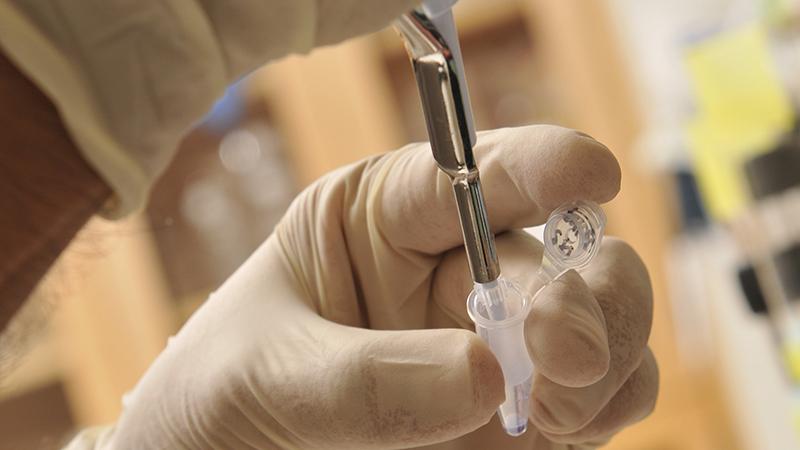Collaboration between Rensselaer Polytechnic Institute and Albany Medical Center develops new techniques
October 27, 2017

Researchers at Rensselaer Polytechnic Institute and Albany Medical Center are working together to develop three-dimensional bioprinting and imaging techniques that will generate and analyze tumor models in the laboratory, with the goal of accelerating the development and optimization of personalized anti-cancer drugs.
The joint research, supported by a $3.7 million grant from the National Cancer Institute, will help address fundamental issues in cancer research and treatment.
“If successful, our study will help researchers to develop personalized anti-cancer treatments,” said David Corr, one of the study’s principal investigators and a Rensselaer associate professor of biomedical engineering associated with the Center for Biotechnology and Interdisciplinary Studies (CBIS). “Ultimately, this research could help clinicians identify whether a particular drug, or drug combination, is effectively reaching the cancer cells in that type of tumor, in that specific person – to inform a patient-specific treatment strategy prior to undergoing chemotherapy.”
In addition to Corr, the researchers leading the project are Xavier Intes, professor of biomedical engineering and co-director of the BioImaging Center at Rensselaer, a center within the CBIS, and Margarida Barroso, an associate professor of molecular and cellular physiology at Albany Medical College.
“One of the main challenges in developing new and effective cancer treatments is the lack of adequate tumor models that can mimic in the laboratory how tumors may behave in a specific individual,” said Corr. “To achieve that, we have to not only develop new 3D bioprinting techniques to generate tumor models with prescribed cell composition and architecture, but also new imaging techniques to visualize how different drugs interact with cancer cells depending on where they are located within these tumor models.”
Current drug treatments can target drugs to cancer cells, but it is difficult to determine whether the drug has actually reached and is able to act on those cancer cells. The imaging assays developed by Barroso and Intes allow researchers to examine the ability of drugs to bind to cancer cells.
“Cancer cells possess specific receptors, which are proteins that act like antennae to which drugs can be targeted to lead to the eradication of tumors,” said Barroso. “Our imaging approach can detect the binding of drugs to those cancer antennae throughout the tumor in its native environment. This allows researchers and clinicians to determine how well a drug actually targets and binds to cancer cells in tumors to make sure that all cancer cells are targeted and not just a small fraction of them.”
The research aligns with the CBIS Cancer Research Group, a large, interdisciplinary group of researchers from across the institute working together to address cancer through a systems-based approach.
“Complex diseases such as cancer require a multifactorial approach. This project is an example of how Rensselaer, with its clinical partners, is changing the Healthcare paradigm by leveraging cutting edge technologies such 3D printing, and developing new imaging tools with a goal to deliver a personalized treatment modality,” said Deepak Vashishth, CBIS director.
Combining the expertise of researchers at Rensselaer and other institutions, in this case Albany Medical College, allows for a unique approach to cancer therapies, and may yield new molecular-level tumor models, and new imaging techniques to monitor the effect of drugs on cancer cells. Corr has developed a laser-printing technique that can create model 3D tumor systems, giving researchers the ability to make different tumor architectures and compositions. The model tumors will replicate an idealized structure that can be used to explore how the distribution of receptors across a tumor affects the efficacy of specific drugs that target those receptors. New imaging techniques developed by Intes and Barroso will make it possible to penetrate the thick tissue of the tumor and view specific molecular interactions between drugs and the receptors on the cancer cells.
At Rensselaer, the research of Corr and Intes fulfills The New Polytechnic, an emerging paradigm for higher education which recognizes that global challenges and opportunities are so great they cannot be adequately addressed by even the most talented person working alone. Rensselaer serves as a crossroads for collaboration — working with partners across disciplines, sectors, and geographic regions — to address complex global challenges, using the most advanced tools and technologies, many of which are developed at Rensselaer. Research at Rensselaer addresses some of the world’s most pressing technological challenges — from energy security and sustainable development to biotechnology and human health. The New Polytechnic is transformative in the global impact of research, in its innovative pedagogy, and in the lives of students at Rensselaer.
About Rensselaer Polytechnic Institute
Rensselaer Polytechnic Institute, founded in 1824, is America’s first technological research university. For nearly 200 years, Rensselaer has been defining the scientific and technological advances of our world. Rensselaer faculty and alumni represent 85 members of the National Academy of Engineering, 17 members of the National Academy of Sciences, 25 members of the American Academy of Arts and Sciences, 8 members of the National Academy of Medicine, 8 members of the National Academy of Inventors, and 5 members of the National Inventors Hall of Fame, as well as 6 National Medal of Technology winners, 5 National Medal of Science winners, and a Nobel Prize winner in Physics. With 7,000 students and nearly 100,000 living alumni, Rensselaer is addressing the global challenges facing the 21st century—to change lives, to advance society, and to change the world. To learn more, go to www.rpi.edu.